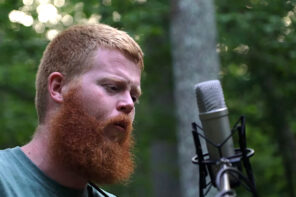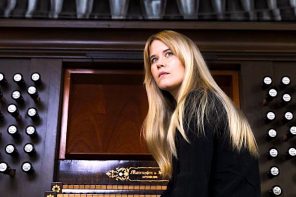It is thirty minutes past midnight, and we are sitting in the dirt among 2,000 or so music lovers in “That Tent” of the Bonnarooo Music and Arts Festival in Manchester, Tennessee. Somewhere, the iconic band Pearl Jam is ending a set at the festival’s largest stage (called the “What” stage) in front of a crowd that must total 40-50,000. But we have opted out of hearing the headliner in order to secure a prime viewing location for Sigur Rós, an ethereal, experimental band that sings many of their songs in their native Icelandic—and some in a nonsense language that the band calls vonlenska or “hopelandic.” We have been waiting for two and a half hours. The people in front of us have been waiting for five. Thirty more minutes to go.
To the extent that we have a Bonnaroo ritual, this is it. The way that the festival is organized, with nonstop performances at five major stages and three smaller ones from the early afternoon to the early morning, it is simply impossible to see everything, or even close to everything, that one might wish to. Most of the bands belong to the kind of rock-and-roll that’s the staple of festivals like Bonnaroo, but the organizers here pride themselves in providing a mix of music that goes beyond that category. This year’s festival includes bluegrass, soul, country, hip-hop, and a special, indoor stage that recreates the feel of a New Orleans jazz club as a venue for acts from that city.
One of the pleasures of Bonnaroo is that a substantial number of the 75-80,000 attendees are curious and savvy fans of contemporary music. What this means is that nearly every act plays to an enthusiastic crowd that includes the deeply devoted, the newly initiated, and the merely curious. What this also means is that if you desire, as we do, to stand close to the stage for your favorite bands, you have to plan ahead. Since most stages have only a half-hour of downtime between performances, we usually come one or two shows earlier than those we are targeting, pushing our way forward to the front in the ebb and flow between performances. This way, we get to hear some performers that we don’t know well, and then end up near the front for at least a few of those whom we do.
This year, though, things have been different. Thanks to this fine publication, we sport blue media wristbands that give us entrée into backstage viewing areas for some, though not all, of the shows. So we have been able to pop back and forth between the tents in order to see the acts that interested us the most—Iron and Wine, Vampire Weekend, Battles. One of the many things we have gleaned from standing backstage is an inkling of what it must feel like to perform in front of such crowds. As the final notes of the song linger in the air, a wave of sound rises from the audience to crash down with an almost physical force. No wonder the performers look drenched when they leave the stage.
By the end of the third day, though, we were tired of watching the audience from a distance, no matter how small. We wanted to be back where we belonged, in the sweaty press of the masses. So here we were, sitting for hours in anticipation of a 1 a.m. set. Near us were the Sigur Rós faithful: a young couple from Santa Fe who decided to come to Bonnaroo because of this show; an Atlanta man who had seen the Icelandic band over a dozen times, sometimes traveling to Europe expressly for that purpose; and a noisy group of Birmingham college students who had been persuaded by one of their number that this was worth the wait.
It was.
It is hard to describe the experience of standing in the second row of a rock concert, untold numbers at your back, without sounding trite. In a world in which it is possible to conduct nearly all communication via one machine or another, to travel from one climate-controlled setting to the next without exchanging so much as a moist handshake, the chance to feel the pulse of motion being exchanged between the performers and the crowd, the energy of the music being returned bodily by the sounds and movement of the audience, may be one of the last things that can remind us what it means that all humans share a common bodily denominator. It is a network of physical reciprocity: each movement on the guitar string or the keyboard produces a wave of sound that trembles, ripples, and echoes through the crowd. There is a reason that ecstatic song forms a key part of so many religious traditions.
Sigur Rós plays its audience as carefully as its instruments. The bands songs have simple melodies, but place layers of sounds upon one another like an aural palimpsest. The guitarist plays his instrument like a cello, with a bow; the keyboardist occasionally plunks out notes on a tiny toy piano; Georg Hólm sometimes uses a drumstick instead of a pick on the strings of his electric bass to bang out a rhythm that sounds like Morse code. When all twelve performers are on stage, the sounds that they make together are nothing less than astonishing. On top of it all rests the falsetto voice of the band’s vocalist, Jón Birgisson, who sings the lyrics with a keening wail:
Bakvio sk´yjaból vaknar sól úr dvala
Svalar sér vio kalda dropa regnsins
leikur sér vio heita loga eldsins
Byr til regnboga
A rough translation reads:
Behind a vessel of clouds,
A sun wakes up from its lethargy
Refreshes itself with some little raindrops
Plays with the hot flames of the fire
Makes rainbows
But we don’t know that at the time. In fact, it is unlikely that more than a handful of the most diehard fans know the meaning of the words to this song, “Hafssól,” that punctuated the concert as its climax. Or rather, the crowd does not know the literal connotations of the words. As the syllables stretch over the simple, quickening rhythms of the band, the music becomes more urgent, but also more joyful. At its end, the song erupts into a frantic pounding and then subsides until the only sound that remains is the thin edge of a pennywhistle. Maybe no one knows the words, but we all understand what the song is saying.
Small wonder that the band’s raucous, hand-clapping new single (and another highlight of its Bonnaroo performance) bears the title “Gobbledigook.” Since its release, dedicated followers of Sigur Rós have been filling Internet discussion boards trying to parse the song’s lyrics. They may be missing the point. Sigur Rós seems to realize that what gives music and musical performance its power is something untranslatable, something in an embodied experience of sound and flesh that cannot be located in a dictionary. It might be a stretch to suggest that this rhythm is in time with sacred chants of the world over, but that was something of the power we felt as the warm bodies around us hung on the notes of Icelandic or Hopelandic or whatever “Gobbledigook” contains. We do know one thing for certain. The band’s newest album is titled Meo suo í eyrum vio spilum endalaust, meaning “with a buzz in our ears we play endlessly.”
We are hoping that the words of this title become a prophecy.




